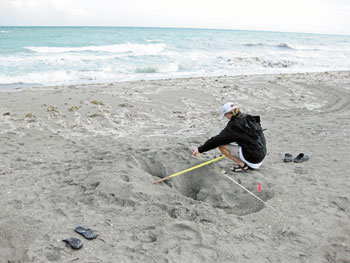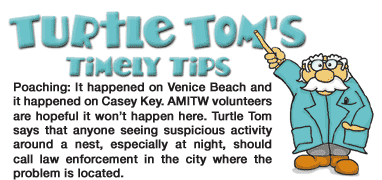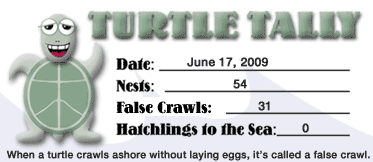Poachers hit Sarasota sea turtle nests

PHOTO COURTESY MOTE MARINE LABORATORY Poachers hit four sea turtle
nests south of the Island last week. Here, one of the four nests,
which were all in Sarasota County, shows classic signs of human
poaching, according to scientists.
Poachers hit four sea turtle nests last week in Sarasota County, taking the entire clutch of eggs from each nest.
"Three of the nests were on Venice Beach and one was on Casey Key," said Ryan Welsh, a Mote Marine Laboratory sea turtle biologist. "They took all the eggs from each nest. The average number of eggs in a nest is 100, so we are assuming they got at least 400 eggs."
The nests were hit with the poaching between June 6 and 12.
"We have local volunteers walk each morning," Welsh said. "They knew something didn’t look right, so we sent out some interns. They thought the nests looked very suspicious, so staff responded. The nests were disturbed and were empty."
Welch said local law enforcement was contacted, and reports were filed.
People steal sea turtle eggs to sell on the black market, according to Welsh.
"Possessing sea turtle eggs without a permit carries a penalty of up to one year in prison and federal fines of up to $100,000," Welsh said. "Then there are state fines of up to $500 plus an additional $100 for each egg taken."
Local authorities are investigating.
All four nests were laid by loggerheads. Sarasota County has the highest density of loggerhead nesting along the entire Gulf of Mexico.
Sea turtle biologists estimate that one out of every 1,000 sea turtle hatchlings lives to reproductive age.
Add to that the habitat loss and problems from lighting, pollution and boat strikes, and it’s clear that each turtle is important to the survival of the species, Welsh said.
Loggerhead sea turtles are listed as a threatened species.
"The chance that one of these eggs would have hatched and become a turtle that made it to adulthood is now lost," Welsh said.
Four-legged poaching
There has been no human poaching on Anna Maria Island, but Anna Maria Island Turtle Watch Volunteers found eggs had been dug up from two nests at Coquina Beach.
"We found broken eggs all around the first nest, and there were a couple outside another nest nearby," Sara Rosenbecker said on Saturday. She and her husband, Howard have been AMITW volunteers for two years.
"We called Lee and Marvin (Zerkle) right away," Rosenbecker said. The Zerkles are the coordinators for that section of beach.
AMITW Director Suzi Fox was called.
"This was a raccoon," she said. "The tracks were clear."
Fox made the decision to place screens over the top of every nest on Coquina Beach.
"The screens cover the nests and extend out about a foot on each side," Fox said. "They aren’t perfect, but they do deter some predation."
The screening is large enough that hatchlings can emerge from the nests and make it to the Gulf.
As for human poaching, Fox and the Rosenbeckers said they are cautiously optimistic that the beaches on Anna Maria Island are too closely watched to allow for human poaching.
Anyone who sees suspicous activity that could be poaching should call law enforcement in the city where the activity is observed. Then call Turtle Watch at 778-5638.



